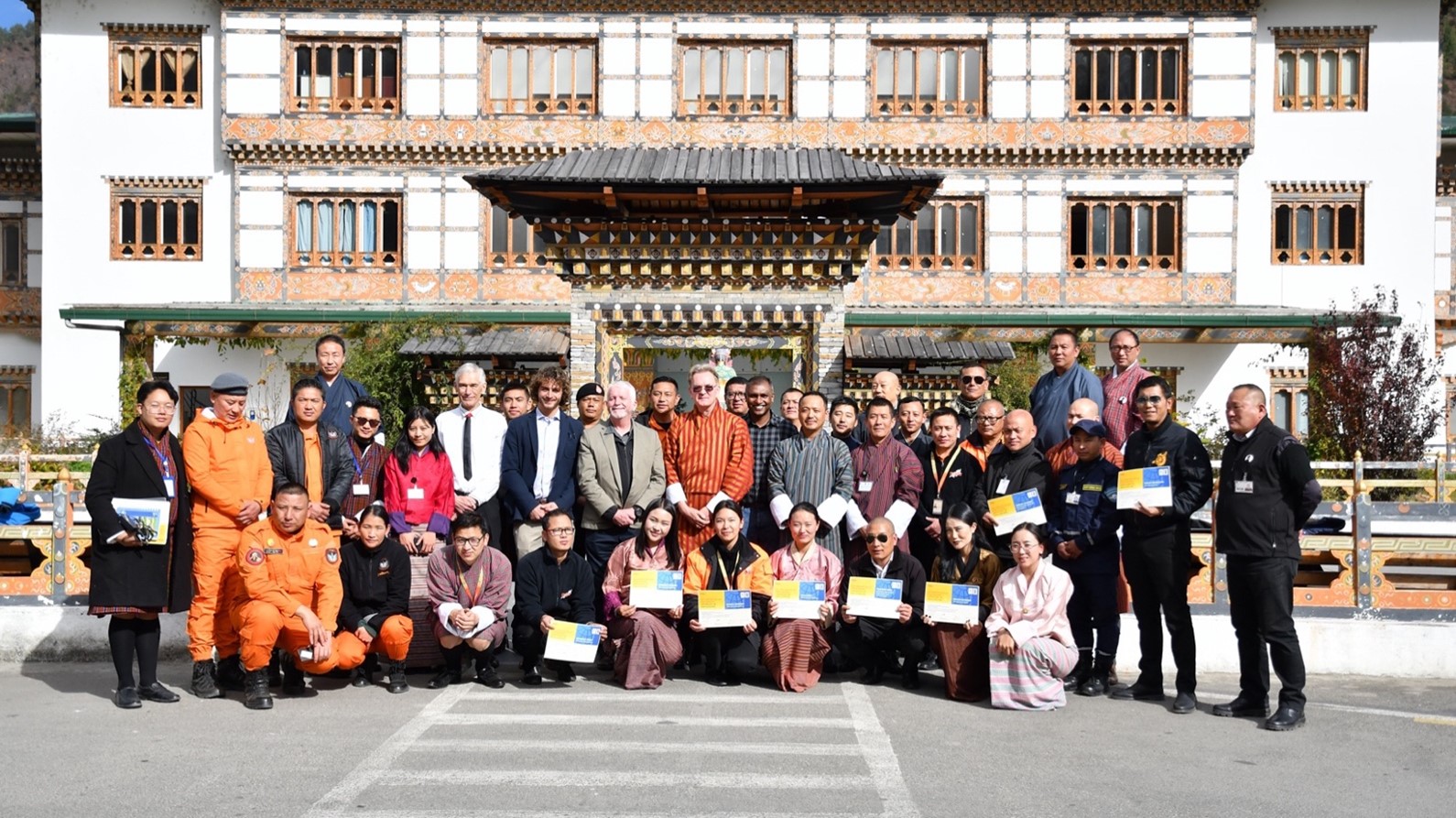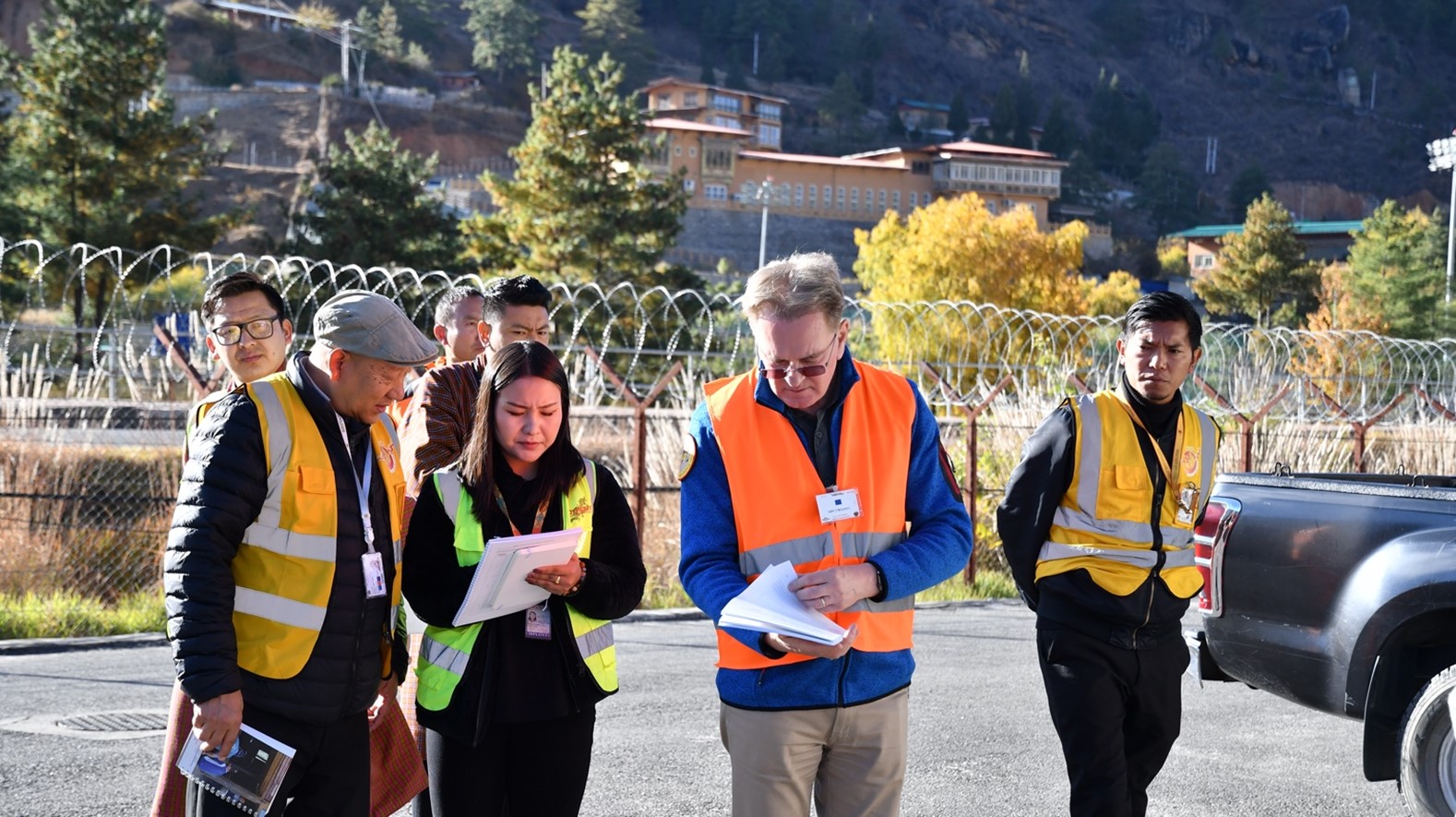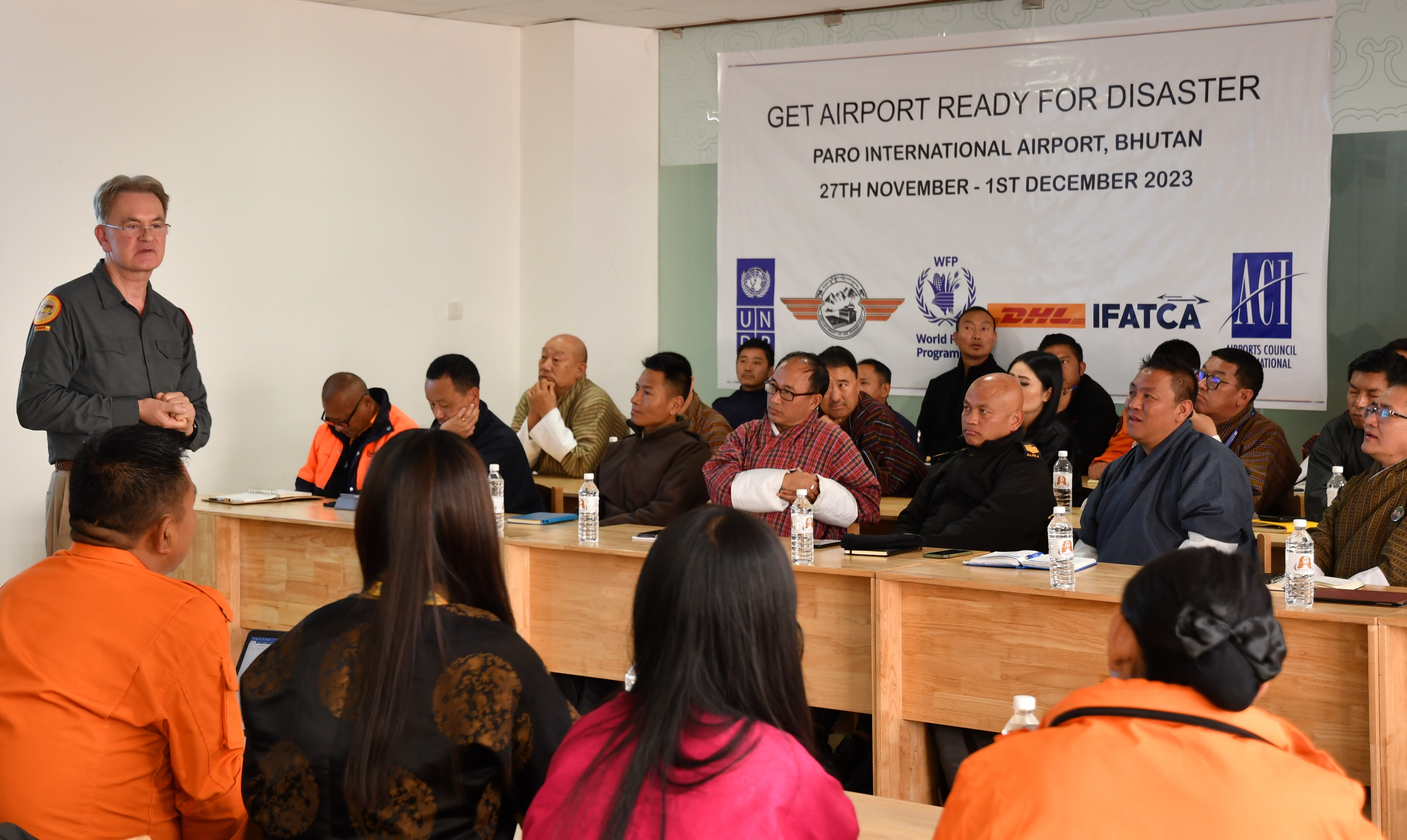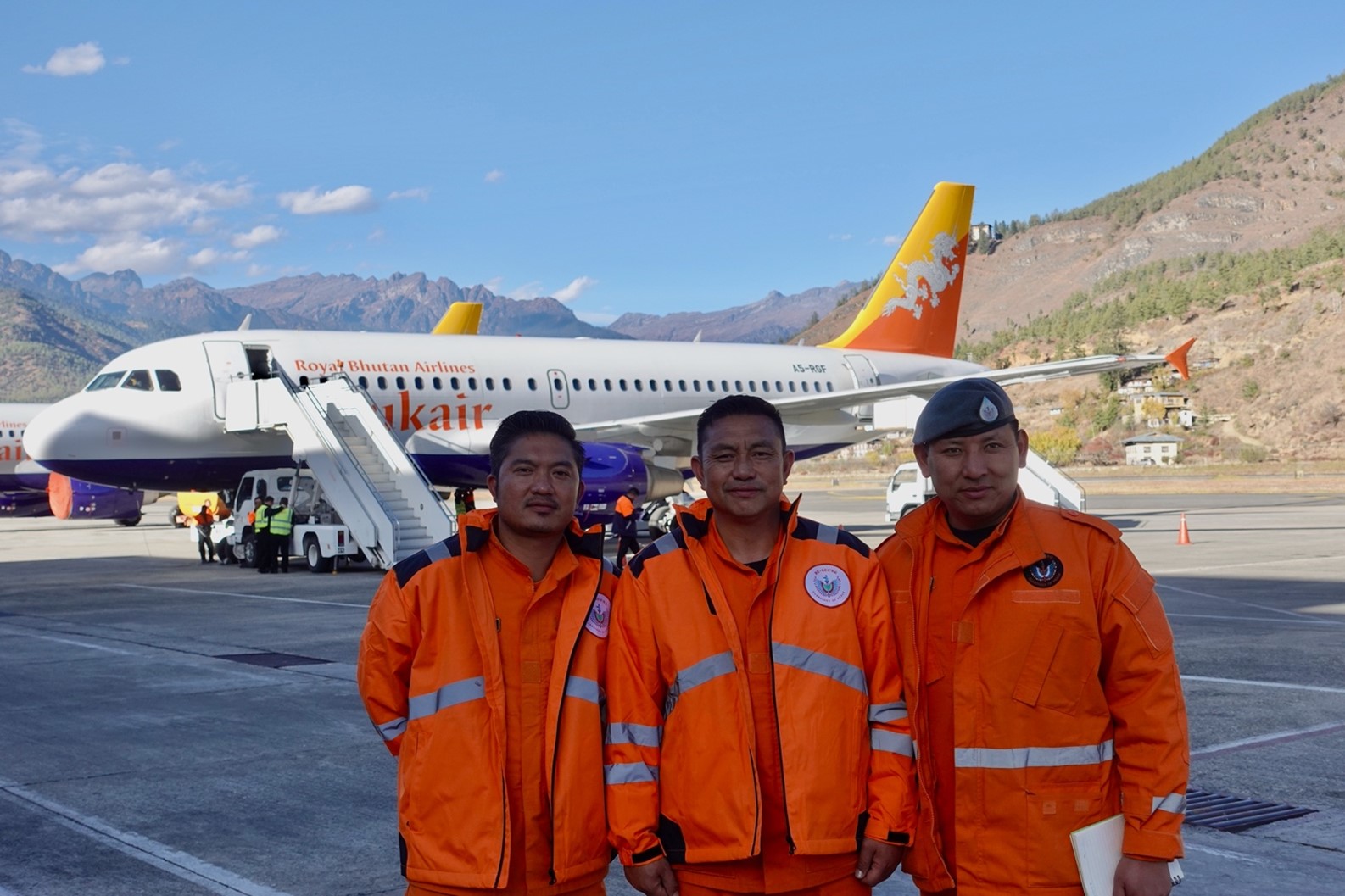By Mohammad Younus, Resident Representative of UNDP Bhutan and Giordano Margaglio, GARD Programme Analyst
Putting Bhutan’s Paro International Airport at the center of national disaster preparedness and response plan
December 6, 2023

GARD Participants at Paro International Airport, Bhutan (November 2023)
Today, as we celebrate International Civil Aviation Day, we reflect on Bhutan’s successful rollout of the Get Airports Ready for Disaster (GARD) programme, paving the way for a coordinated disaster preparedness in a country located in a seismologically active and fragile Himalayan region.
Airports play an important role in a coordinated response in times of disasters and emergencies. Beyond being a point of entry, airports are lifelines for people most in need, serving as logistical hubs for immediate disaster response, ensuring inflow of critical humanitarian aid and personnel.
Therefore, the GARD programme—a longstanding global partnership between UNDP and DHL Group—focuses on getting the airports ready for disasters. From 27 November to 1 December 2023, Bhutan embarked on its first GARD exercise at Paro International Airport, which is a vital and timely initiative that saw key national and international stakeholders joining forces to integrate the role of the airport into the national disaster preparedness and response ecosystem.
UNDP and DHL Group partnered with the Department of Air Transport, Bhutan Civil Aviation Authority, Department of Local Governance and Disaster Management, World Food Programme (WFP) and the Airports Council International for Asia Pacific and the Middle East.

Cargo group during the airport walkabout at Paro International Airport, Bhutan (November 2023)
A leader in environmental stewardship
Bhutan has not only captivated the world with its stunning landscapes and vibrant culture but has also emerged as a global environmental trailblazer. The nation has achieved a remarkable feat of being among the three carbon-negative countries in the world, setting an inspiring example for others to follow.
Bhutan's commitment to climate action and environment conservation is deeply underpinned by its holistic development philosophy of Gross National Happiness – a unique approach to measuring development that prioritizes the happiness and well-being of its people and environment over mere economic indicators. Bhutan’s constitution mandates that at least 60 percent of the country remains under forest cover for all time. Currently, thanks to the country’s visionary leadership and conscious policies, its forest coverage stands at 71 percent.
Bhutan’s pledge to environmental conservation does not exempt the country from the impact of climate crisis and disasters. In addition to climate change induced risks and vulnerabilities, Bhutan sits on one of the world's most seismically active zones. A seven-year study of the country’s geodynamics warned that Bhutan could be hit by a magnitude 8 earthquake. Another study warned that an earthquake occurring at night could severely affect nearly 10 percent of the population.
The earthquakes of 2009 and 2011, measuring 6.1 and 6.9 in magnitudes respectively, remain vivid memories for the people of Bhutan. Thousands of rural homes and public buildings, as well as cultural and religious monuments were damaged, causing an estimated loss equivalent to over 3 percent of the country’s GDP.
With glaciers retreating at an unprecedented rate due to climate change, Bhutan faces increasing threat of glacial lake outburst floods. The country has 567 glacial lakes, and 17 among them have been identified as high risk, meaning they could burst any time due to global warming or seismic events. These risks serve as a stark reminder of how important it is to be prepared for disasters.
A unique airport nestled in the Himalayas
Nestled in a small valley surrounded by towering Himalayan peaks, the Paro International Airport is recognized as one of the most perilous and challenging airports on Earth. With only 17 pilots qualified to fly in and out, Bhutan’s only international airport, is not only a critical infrastructure but a lifeline connecting the country to the rest of the world. This unique geographical profile entails several implications for aviation procedures, including the size of aircrafts that can land on the runway, strict authorization protocols, and the operability of the airport exclusively during daylight hours.

The spectacular Himalayan range surrounding Paro International Airport, Bhutan (November 2023)
The GARD exercise in Paro underscored that disaster preparedness must be tailored to the diverse and unique environments in which it is applied, especially in places where the challenges faced are as vast as the landscapes themselves.

Carl Schelfhaut, Head of the GoHelp Program for Asia Pacific, DHL Group introducing GARD programme to participants on day one of the exercise (November 2023)
“The GARD programme aims to get as many airports as possible in high-risk countries prepared for disaster. We are happy to see Bhutan participating with the support of our partners. The location of the airport presents unique challenges and we have worked with the local team in getting them disaster-ready. We are encouraged that this workshop will contribute considerably to the country's efforts to create a robust disaster resilience standard for its airport."Carl Schelfhaut, Head of the GoHelp Program for Asia Pacific, DHL Group
The first step toward a new vision
The recent GARD workshop at Paro International Airport marks a significant milestone in Bhutan's pursuit of disaster resilience and risk-informed development. More than 50 participants representing key stakeholders, working at both local and national levels, assessed the airport’s maximum processing capacity in terms of goods and passengers, facilities, cargo, and operations/air traffic control of the airport.
The collaborative effort resulted in the successful assessment of the Airport Surge Capacity and formulation of a comprehensive Action Plan. The action plan outlines low-cost, high-impact recommendations and will serve as a blueprint to fortify Paro airport's ability to respond swiftly and effectively during disasters.
As Karma Wangchuk, Director General at the Department of Air Transport and Owner of the GARD programme nationally ,emphasized, “the GARD programme indeed signifies the inaugural step on a long-term journey toward sustained engagement”.

Members of De-suung – or “Guardians of Peace” – a National Service project counting more than 42,000 volunteers in Bhutan (November 2023)
Shared ownership for a resilient future
The shared commitment of diverse actors underscores Bhutan's proactive approach to building a robust foundation for disaster preparedness and response. This commitment ensures that the kingdom's gateway is not only a beautiful architecture but also resilient.
Building on UNDP’s five decades of partnership with the Royal Government of Bhutan, and in line with our upcoming Country Programme Document (2024-2028), we will continue to work with our UN family, national and international partners in support of Bhutan’s efforts to advance a whole-of-society approach to carbon-neutral, nature-positive, and risk-informed development.
Bhutan, with its resilient spirit, stands as a beacon for other nations navigating the delicate balance between development and disaster preparedness.

 Locations
Locations


